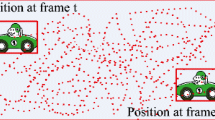Abstract
Rather than the difficulties of highly non-linear and non-Gaussian observation process and the state distribution in single target tracking, the presence of a large, varying number of targets and their interactions place more challenge on visual tracking. To overcome these difficulties, we formulate multiple targets tracking problem in a dynamic Markov network which consists of three coupled Markov random fields that model the following: a field for joint state of multi-target, one binary process for existence of individual target, and another binary process for occlusion of dual adjacent targets. By introducing two robust functions, we eliminate the two binary processes, and then apply a novel version of belief propagation called sequential stratified sampling belief propagation algorithm to obtain the maximum a posteriori (MAP) estimation in the dynamic Markov network. By using stratified sampler, we incorporate bottom-up information provided by a learned detector (e.g. SVM classifier) and belief information for the messages updating. Other low-level visual cues (e.g. color and shape) can be easily incorporated in our multi-target tracking model to obtain better tracking results. Experimental results suggest that our method is comparable to the state-of-the-art multiple targets tracking methods in several test cases.
Similar content being viewed by others
References
Bar-Shalom, Y., Li, X. R., Multitarget Multisensor Tracking: Principles and Techniques, Storrs, CT: YBS Publishing, 1995.
Reid, D. B., An algorithm for tracking multiple targets, IEEE Trans. on Automatic Control, 1979, 24(6): 843–854.
Cox, I. J., Hingorani, S. L., An efficient implementation of reid’s multiple hypotheses tracking algorithm and its evaluation for the purpose of visual tracking, IEEE Trans. on Pattern Analysis and Machine Intelligence, 1996, 18(2): 138–150.
Fortmann, T. E., Bar-Shalom, Y., Scheffe, M., Sonar tracking of multiple targets using joint probabilistic data association, IEEE Journal Oceanic Eng., 1983, OE-8: 173–184.
Hue, C., Le Cadre, J. P., Perez, P., Tracking multiple objects with particle filtering, IEEE Trans. on Aerospace and Electronic Systems, 2002, 38(3): 791–812.
Isard, M., MacCormick, J. P., Bramble: A Bayesian multiple-blob tracker, In Intl. Conf. on Computer Vision, 2001, II: 34–41.
MacCormick, J. P., Blake, A., A probabilistic exclusion principle for tracking multiple objects, In Intl. Conf. on Computer Vision, 1999, 572–578.
Tao, H., Sawhney, H. S., Kumar, R., A sampling algorithm for tracking multiple objects, In Workshop on Vision Algorithms 99, 1999, 53–68.
Tweed, D. et al., Tracking objects using subordinated condensation, in Proc. British Machine Vision, 2002, 283–292.
Isard, M., Blake, A., Condensation—conditional density propagation for visual tracking, International Journal on Computer Vision, 1998, 29(1): 5–28.
Okuma, K. et al., A boosted particle filter: Multitarget detection and tracking, In European Conference on Computer Vision, 2004, 1: 28–39.
Vermaak, J., Doucet, A., Perez, P., Maintaining multi-modality through mixture tracking, Intl. Conf. on Computer Vision, 2003, 2: 1110–1116.
Viola, P., Jones, M., Robust real time object detection, IEEE ICCV Workshop on Statistical and Computational Theories of Vision, Vancouver, Canada, 2001, July 13.
Yu, T., Wu, Y., Collaborative tracking of multiple targets, IEEE Conf. on Computer Vision and Pattern Recognition, 2004, 1: 834–841.
Zhang, Y. P., Zheng, N. N., Zha, R. C., Variation-based approach to image segmentation, Science in China, Series F, 2001, 44(4): 259–269.
Murphy, K., Weiss, Y., Jordan, M., Loopy-belief propagation for approximate inference: An empirical study, in Proc. Fifteenth Conference on Uncertainty in Artificial Intelligence, Stockholm, Sweden, July 1999, 467–475.
Comaniciu, D., Ramesh, V., Meer, P., Real-time tracking of non-rigid objects using mean shift, In Proc. IEEE Conf. on Computer Vision and Pattern Recognition, 2000, 2: 142–149.
Black, M. J., Rangarajan, A., On the unification of line processes, outlier rejection and robust statistics with applications in early vision, International Journal on Computer Vision, 1996, 19(1): 57–91.
Osher, S., Rubin, L. I., Fatemi, E., Nonlinear total variation based noise removal algorithms, Physics D, 1992, 27(60): 259–268.
Sudderth, E., Ihler, A., Freeman, W., Willsky, A., Nonparametric belief propagation, IEEE Conf. on Computer Vision and Pattern Recognition, 2003, I: 605–612.
Isard, M., PAMPAS: Real-valued graphical models for computer vision, IEEE Conf. on Computer Vision and Pattern Recognition, 2003, I: 613–620.
Hua, G., Wu, Y., Multi-scale visual tracking by sequential belief propagation, IEEE Conf. on Computer Vision and Pattern Recognition, 2004, 1: 826–833.
Author information
Authors and Affiliations
Corresponding author
Rights and permissions
About this article
Cite this article
Xue, J., Zheng, N. & Zhong, X. Sequential stratified sampling belief propagation for multiple targets tracking. SCI CHINA SER F 49, 48–62 (2006). https://doi.org/10.1007/s11432-004-0140-6
Received:
Accepted:
Issue Date:
DOI: https://doi.org/10.1007/s11432-004-0140-6




